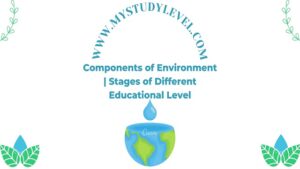Components of Environment In India
Chief goals of Environmental Studies: Chief goals of environmental education must be
i) To improve the quality of environment,
ii) To create an awareness among the people on environmental problems and conservation and
iii) To create an atmosphere so that people participate in decision making and develop the capabilities to evaluate the developmental programs.
Components of Environment In India
The spectrum of environmental education has four major, integrating and interrelated components i.e.,
I. Awareness: Awareness that include making the individual conscious about the physical, social and aesthetic aspects of environment. The environmental regime in linked with the life support system which in itself has six elements: air, water, land, flora and fauna and the incoming sunlight. These have dynamic relationship. Man, being most important species has major responsibilities.

components of environment in india
Components of Environment In India
II. Real-Life situations: Real-Life situations are that link environment to life, these conditions are location specific, thus problems and priorities of each area may be different.

III. Conservation: Conservation is which is the management of resources for the benefit of all life including humankind of the biosphere so that it may yield sustainable benefit to the present generation while maintaining its potential to meet the needs and aspirations of the future generation.
IV. Sustainable Development: Sustainable Development is where spot light would be on utilization and not on exploitation, In the former, the idea is that all resources are finite and there is also a limit to the growth of living systems. Thus resources are to be used in wise manner. Sustainable development aims at utilization of resources not only by the present but also by the future generations in a manner that utilization (and not exploitation) is balanced. Utilization of resources for development is always associated with some negative impacts. Thus efforts are to be made to contain or minimize them.
Components of Environment In India
Environmental Education at different educational stages
Primary School Stage: At primary school stage the emphasis must be given on building up awareness (75%), followed by real-life situations (20%) and conservation (5%). Thus attempt should be to only sensitive the child about environment. The content to be used are surrounding from home to school to outdoor situations. Teaching strategy includes audio-visual and field visits.
2. Lower Secondary Stage: From the lower secondary stage on wards, the quantum of awareness must decrease and there should be increased knowledge of real-life situations, conservation and sustainable development. At lower secondary level, objective must be real life experience, awareness and problem identification. The contents to be used are those at Primary School Level supplemented with general science. Teaching practical and field visits are to be done.
3. Higher Secondary School stage: At Higher Secondary School Stage the emphasis must be on conservation, assimilation of knowledge, problem identification and actions kills. The content used may be science-based and action oriented work. The content should be proper teaching, practical’s and field work. Many developing countries like India, USA, Canada and many other countries face problems of lack of resource materials, funds, and trained instructors and teachers at secondary school stage.
Components of Environment In India
4. Tertiary (College) Stage: At this level, the picture would be almost reverse of the primary level, as maximum emphasis would be here on knowledge regarding sustainable development based on experience with conservation followed, in a descending order by conservation, real-life situations and awareness. The content must be College/University based on Science and Technology. Teaching, practical and action-oriented field work is to be done. In the school education, NCERT has been playing vital role in designing syllabi, text books, help books, guide books, charts, kits, teaching materials and aids both for students and teachers.

components of environment in india
5. Universities Education: At universities Environmental education at this level is being looked after the University Grants Commission. There is a high-powered committee to suggest areas of EE at post-graduate level. There are about 10 Universities teaching courses Environmental areas. Besides these, there are also research institutes and professional institutions as Institute of Technology, Engineering Colleges, Schools of planning and Architecture, which offer course in environmental engineering. The Universities education has three major components:
Components of Environment In India
i. Teaching ii. Research and iii. Extension
At Postgraduate level, four major areas are recognized:
a) Environmental Engineering: It includes the subjects like architecture, civil engineering, town and country planning, including human settlement, slum improvement, landscape architecture industrial design, regional science and urban ecosystem studies.
b) Conservation and Management: It includes fields like land use, forestry, agriculture energy, waste management, wild life management, national parks, biosphere, biological diversity, water management, mining management, non-polluting renewable energy development etc.
Components of Environment In India
c) Environmental Health: This deals with public health and hygiene, sanitary and chemical engineering, occupational health, toxicology, nutrition and drug use etc.
d) Social ecology: It includes subjects like ecology, sociology, social planning, cost-benefit, community organizations and services, psychology and counseling, environmental ethics and related areas of humanities.

Components of Environment In India













Leave a Reply